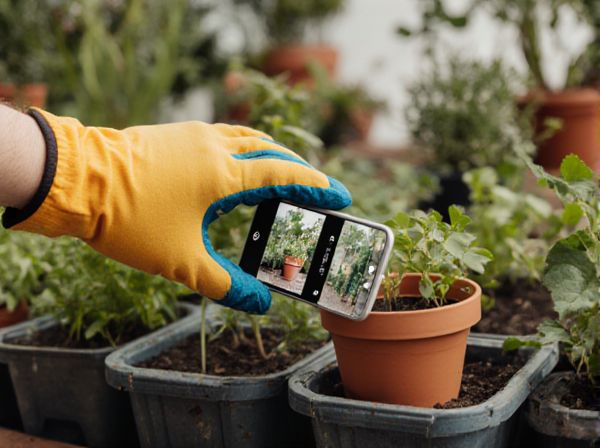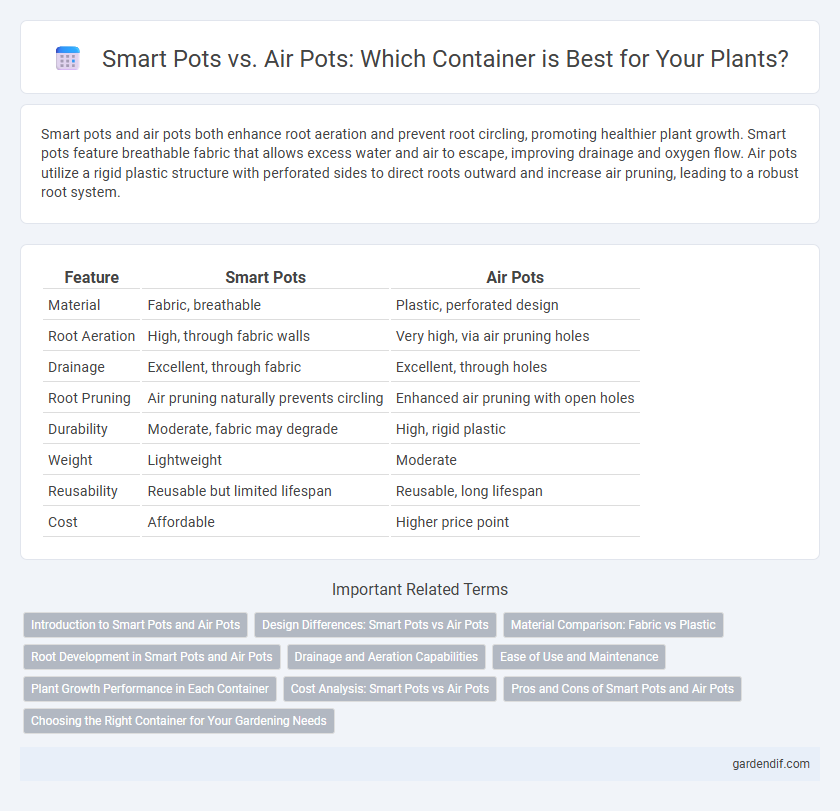
Smart pots vs air pots Illustration
Smart pots and air pots both enhance root aeration and prevent root circling, promoting healthier plant growth. Smart pots feature breathable fabric that allows excess water and air to escape, improving drainage and oxygen flow. Air pots utilize a rigid plastic structure with perforated sides to direct roots outward and increase air pruning, leading to a robust root system.
Table of Comparison
| Feature | Smart Pots | Air Pots |
|---|---|---|
| Material | Fabric, breathable | Plastic, perforated design |
| Root Aeration | High, through fabric walls | Very high, via air pruning holes |
| Drainage | Excellent, through fabric | Excellent, through holes |
| Root Pruning | Air pruning naturally prevents circling | Enhanced air pruning with open holes |
| Durability | Moderate, fabric may degrade | High, rigid plastic |
| Weight | Lightweight | Moderate |
| Reusability | Reusable but limited lifespan | Reusable, long lifespan |
| Cost | Affordable | Higher price point |
Introduction to Smart Pots and Air Pots
Smart Pots are fabric containers designed to enhance root aeration and prevent root circling, promoting healthier plant growth through improved oxygen exposure. Air Pots feature a unique, perforated plastic structure that encourages extensive root branching and air pruning by allowing roots to reach air pockets. Both container types optimize root development but utilize different materials and mechanisms to maximize plant health and growth efficiency.
Design Differences: Smart Pots vs Air Pots
Smart Pots feature a flexible, non-woven fabric design that promotes air pruning by allowing roots to naturally encounter air and halt growth, preventing root circling. Air Pots utilize rigid plastic side vents combined with a unique pot shape to force roots into a controlled airflow environment, enhancing oxygen exposure and encouraging dense, fibrous root systems. The key design difference lies in Smart Pots' breathable fabric walls versus Air Pots' mechanical air pruning through vented plastic cavity structures.
Material Comparison: Fabric vs Plastic
Smart pots are made from breathable fabric that enhances root aeration and prevents overwatering, promoting healthier plant growth. Air pots are constructed from durable plastic with perforated sides designed to improve airflow and encourage root pruning. Fabric material in smart pots offers flexibility and reusability, whereas plastic in air pots provides rigidity and longer lifespan under varied environmental conditions.
Root Development in Smart Pots and Air Pots
Smart Pots promote robust root development by allowing air pruning through their breathable fabric, preventing root circling and encouraging a dense, fibrous root system. Air Pots use a unique perforated plastic design that dynamically prunes roots when they reach the container edge, stimulating lateral root growth and enhancing nutrient uptake. Both containers optimize oxygen flow to roots, but Smart Pots excel in moisture regulation while Air Pots focus on maximizing root surface area for improved plant health.
Drainage and Aeration Capabilities
Smart pots feature breathable fabric walls that provide excellent drainage and promote air circulation directly to the root zone, preventing waterlogging and enhancing root health. Air pots incorporate rigid plastic structures with perforated sides that facilitate superior aeration and drainage by air pruning roots, encouraging a more fibrous root system. Both options significantly improve oxygen availability to roots compared to traditional containers, but air pots offer more controlled airflow and root development benefits.
Ease of Use and Maintenance
Smart pots offer superior ease of use and maintenance compared to air pots, as their fabric design promotes natural root pruning without requiring frequent checks or adjustments. Air pots demand more attention due to their rigid plastic structure and perforated walls, which can accumulate debris and require regular cleaning. The lightweight and flexible fabric of smart pots simplifies handling, making them ideal for growers seeking low-maintenance container solutions.
Plant Growth Performance in Each Container
Smart pots enhance plant growth by promoting superior aeration and drainage through their fabric construction, which encourages robust root development and prevents root circling. Air pots feature perforated walls that increase oxygen exposure and improve root pruning, leading to healthier, more fibrous root systems and accelerated growth rates. Both container types outperform traditional pots by optimizing root environment, but smart pots excel in moisture regulation, while air pots provide more effective air pruning.
Cost Analysis: Smart Pots vs Air Pots
Smart Pots generally offer a lower initial cost compared to Air Pots, making them a budget-friendly choice for gardeners. Air Pots tend to be more expensive upfront but provide enhanced aeration and root pruning benefits that can lead to healthier plant growth and potentially higher yields. When considering long-term value, the efficiency and durability of Air Pots may justify the higher price for commercial growers seeking optimized plant performance.
Pros and Cons of Smart Pots and Air Pots
Smart pots offer superior root aeration and drainage, promoting healthy root growth and reducing the risk of root rot, but they may dry out faster requiring more frequent watering. Air pots enhance oxygen exposure to roots through their unique perforated design, increasing nutrient uptake and preventing root circling, yet they can be bulkier and less visually appealing for some growers. Both options improve plant health compared to traditional pots, but the choice depends on specific plant needs, watering habits, and space considerations.
Choosing the Right Container for Your Gardening Needs
Smart pots offer excellent aeration and root pruning through their breathable fabric, which promotes healthier root systems and faster growth. Air pots feature rigid plastic construction with porous sides that prevent root circling and improve oxygen flow, ideal for vigorous plants needing strong root structures. Selecting between smart pots and air pots depends on your plant type and watering habits, with smart pots being more flexible and lightweight, while air pots provide superior drainage and durability.
Smart pots vs air pots Infographic

 gardendif.com
gardendif.com